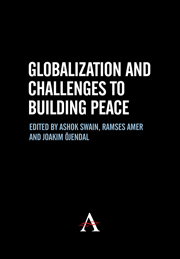Book contents
- Frontmatter
- Contents
- Acknowledgements
- List of Contributors
- 1 Building Peace in the Era of Three Waves
- 2 The Problem of Peace: Understanding the ‘Liberal Peace’
- 3 Pre-emptive Self-defence New Legal Principle or Political Action?
- 4 Beyond Criminal Justice: Promoting the Rule of Law in Post-Conflict Societies
- 5 Peace by Pact: Data on the Implementation of Peace Agreements
- 6 Refugee Repatriation as a Necessary Condition for Peace
- 7 Catapulting Conflicts or Propelling Peace: Diasporas and Civil Wars
- 8 UN Peace Operations as Norm Entrepreneurs: The Challenge of Achieving Communicative Action on Human Rights
- 9 To Practice What They Preach: International Transitional Administrations and the Paradox of Norm Promotion
- 10 Re-examining the Roots of War in West Africa in a Globalizing World
- 11 The African Union (AU) and Its Commitment to Non-Indifference: Can the AU be an Actor for the Promotion of Human Security?
- 12 Hamas Between Sharia Rule and Demo-Islam
- 13 Environmental Scarcity and Intrastate Conflicts: The Case of Nepal
- 14 Narcotics: The New Security Threat for China
- References
- Bibliography
2 - The Problem of Peace: Understanding the ‘Liberal Peace’
Published online by Cambridge University Press: 05 March 2012
- Frontmatter
- Contents
- Acknowledgements
- List of Contributors
- 1 Building Peace in the Era of Three Waves
- 2 The Problem of Peace: Understanding the ‘Liberal Peace’
- 3 Pre-emptive Self-defence New Legal Principle or Political Action?
- 4 Beyond Criminal Justice: Promoting the Rule of Law in Post-Conflict Societies
- 5 Peace by Pact: Data on the Implementation of Peace Agreements
- 6 Refugee Repatriation as a Necessary Condition for Peace
- 7 Catapulting Conflicts or Propelling Peace: Diasporas and Civil Wars
- 8 UN Peace Operations as Norm Entrepreneurs: The Challenge of Achieving Communicative Action on Human Rights
- 9 To Practice What They Preach: International Transitional Administrations and the Paradox of Norm Promotion
- 10 Re-examining the Roots of War in West Africa in a Globalizing World
- 11 The African Union (AU) and Its Commitment to Non-Indifference: Can the AU be an Actor for the Promotion of Human Security?
- 12 Hamas Between Sharia Rule and Demo-Islam
- 13 Environmental Scarcity and Intrastate Conflicts: The Case of Nepal
- 14 Narcotics: The New Security Threat for China
- References
- Bibliography
Summary
To remember Hiroshima is to commit oneself to peace.
Pope John Paul II, 1981Pax Invictis Virtue runs amok.
Attributed to G K ChestertonIntroduction
What is peace? This essay examines the genealogy of the ‘problem of peace’. This is not as commonly thought caused by the contestation of power by sovereign actors (Carter, 1936, p. xi) but rather by the absence of debate on the conceptualisation of peace, and the consequence of assuming it is a negative epistemology that can never fully be achieved (Rasmussen, 2003, p. 174). Instead, it is generally assumed that the ‘liberal peace’ is acceptable to all. This is essentially what Mandelbaum and others have called the combination of peace, democracy and free markets (Mandelbaum, 2002, p. 6; Duffield, 2001, p. 11; Paris, 2004). These assumptions are also prevalent in most policy documents associated with peace and security issues (United Nations, 2004; International Development Research Centre 2001). The liberal peace is assumed to be unproblematic in its internal structure, and in its acceptance in post-conflict zones, though its methodological application may be far from smooth (Paris, 2004, p. 18–20). Yet, the liberal peace's main components – democratisation, the rule of law, human rights, free and globalized markets, and neo-liberal development – are increasingly being critiqued from several different perspectives.
- Type
- Chapter
- Information
- Globalization and Challenges to Building Peace , pp. 17 - 38Publisher: Anthem PressPrint publication year: 2007
- 2
- Cited by

